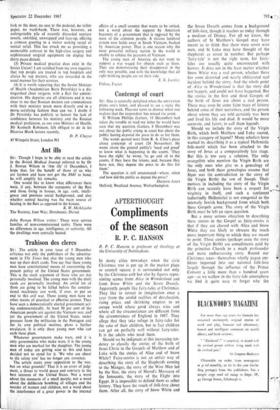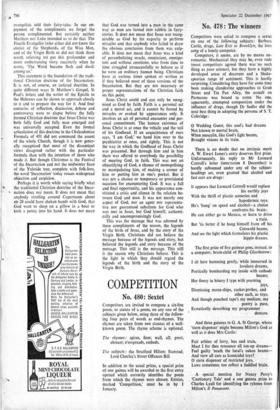Compliments of the season
AFTERTHOUGHT R. P. C. HANSON
R. P. C. Hanson is professor of theology at the University of Nottingham.
In many cities nowadays when the civic Christmas tree is put up in the market place or council square it is surrounded not only by the Christmas crib but also by figures repre- senting scenes from Alice in Wonderland and from Snow White and the Seven Dwarfs. Apparently people like fairy-tales at Christmas. They like to retreat in imagination once a year from the sordid realities of devaluation, rising prices and shrinking empires to an escape world where good always wins and where all the circumstances are different from the circumstances of England in 1967. They allege that they take refuge in fairy-tales for the sake of their children, but in fact children can get on perfectly well without fairy-tales. It is the adults who need them.
Should we be indignant at this increasing ten- dency to classify the stories of the birth of Jesus Christ in the Gospels of Matthew and of Luke with the stories of Alice and of Snow White? Fairy-storiei is not an unfair way of describing the story of the Shepherds coming to the Manger, the story of the Wise Men led by the Star, the story of Herod's Massacre of the Innocents, the story of the Flight into Egypt-It is impossible to defend them as sober history. They have the touch of folk-lore about them. After all, the story of Snow White and
the Seven Dwarfs comes from a background of folk-lore, though it reaches us today through a medium of Disney. For all we know, the authors of St Matthew's Gospel may have meant us to think that there were seven wise men, and St Luke may have thought of the shepherds as seven in number. But perhaps 'fairy-tale' is not the right term, for fairy- tales are usually quite unconnected with history. It does not in the least matter whether Snow White was a real person, whether there lies some distorted and nearly obliterated real incident behind the story. And the whole point of Alice in Wonderland is that the story did not happen, and could not have happened. But the stories in the first and third Gospels of the birth of Jesus are about a real person. There may even be some faint trace of history behind some of their narratives, and the person about whom they are told certainly was born and lived his life and died. It would be more accurate, and fairer, to call them legends.
Should we include the story of the Virgin Birth, which both Matthew and Luke record, in-this category of legend? Many scholars have wanted to, describing it as a typical Hellenistic folk-motif which has been attached to the story of Jesus at a comparatively late stage. But this , is too easy a solution. The only evangelists who mention the Virgin Birth are the only ones who give us a genealogy of Jesus, and both these genealogies assume that refuS was (in contradiction to the story of the Virgin Birth) the son of Joseph. Their motives in including the story of the Virgin Birth can scarcely have been a respect for virginity in itself, and such a sentiment* (admittedly Hellenistic) is not congenial to the intensely Jewish background from which both these Gospels arose. The story of the Virgin Birth must be left 'an open question.
But a more serious objection to describing these stories in the Gospel as fairy-stories is that if they are classed with Alice and Snow White they are likely to obscure the much more important thing to which they are meant to point. These stories (perhaps even the story of the. Virgin Birth) are compliments paid by the primitive Church to a much profounder and more embarrassing story. Round our ,Christmas trees—themselves wholly pagan em- blems imported into our national folk-lore largely through the influence of the Prince Consort a little more- than a hundred years ago—as we wallow in the fairy-tale atmosphere we find it quite easy to forget why the
evangelists told their fairy-tales. In our en- joyment of the compliments we forget the person complimented. But certainly neither Matthew nor Luke intended us to do that. The Fourth Evangelist (who either did not know the stories of the Shepherds, of the Wise Men, and of the Virgin Birth or did not think them worth referring to) put this profounder and more embarrassing story succinctly when he wrote, 'The Word became flesh and dwelt among us.'
This statement is the foundation of the tradi- tional Christian doctrine of the Incarnation. It is not, of course, an isolated doctrine. In quite different ways St Matthew's Gospel, St Paul's letters and the writer of the Epistle to the Hebrews can be shown to approach closely to it and to prepare the way for it. And four centuries of reflection, discussion, debate and controversy were to elapse before the fully formed Christian doctrine that Jesus Christ was both fully God and fully man emerged and was universally. accepted. Even the formal articulation of this doctrine in the Chalcedonian Formula of 451 did not command the assent of the whole Church, though it is now gener- ally recognised that most of the dissentient views disagreed rather with the particular formula than with the intention of those who made it. But though Christmas is the Festival of the Incarnation and not the midwinter feast of the Yuletide tree, complete with folk-lore, the word 'Incarnation' today rouses widespread objection and suspicion.
Perhaps it is worth while saying briefly what the traditional Christian doctrine of the Incar- nation does not mean. It does not mean that anybody strolling around Capernaum about AD 28 could have shaken hands with God, that God went to sleep on a pillow in a boat or took a penny into his hand. It does not mean
that God was turned into a man in the same way as men are turned into rabbits in fairy- stories. It does not mean that Jesus was recog- nisable as God by his capacity to perform miracles and that anybody who failed to draw the obvious conclusion from them was culp- able. It does not mean that Jesus was a kind of perambulating oracle, omniscient, omnipo- tent and without emotions, who from time to time struggled unsuccessfully to behave as if he were an ordinary human being. Christians have at various times spoken or written as if they believed most of these versions of the Incarnation. But they are not necessary or proper representations of the Christian faith on this point.
Jesus Christ could and can only be recog- nised as God by faith. Faith is a personal act and a moral act, and it cannot be forced by miracles or evoked by appearances only. It involves an act of personal encounter and per- sonal commitment. The human existence of Jesus Christ is at once the vehicle and the veil of his Godhead. If an acquaintance of ours says, 'I am God,' we hand him over to the psychiatrist at once, and rightly. This is not the way in which the Godhead of Jesus Christ was presented. But through him and in him there was offered to everybody the possibility of meeting God, in faith. This was not an objectifying of God, a chance of monopolising or manipulating him, of making a corner of him or putting him in one's pocket. But it was not a chance or temporary or provisional occasion for encountering God. It was a full and final opportunity, and his appearance con- stituted a crisis and climax in the relation be- tween God and man. It was not merely one aspect of God, nor an agent nor representa- tive nor guaranteed substitute for God who was met in Jesus, but God himself, authenti- cally and uncompromisingly God.
This was the message that was adorned by these compliments of the season, the legends of the birth of Jesus, and by the story of the Virgin Birth. Christians did not believe the message because of the legends and story, but believed the legends and story because of the message. This still is the message. This still is the reason why Christians believe. This is the light in which they should regard the legends of the birth and the story of the Virgin Birth.



































 Previous page
Previous page